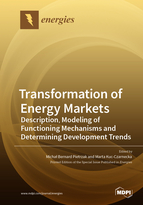Transformation of Energy Markets: Description, Modeling of Functioning Mechanisms and Determining Development Trends
A special issue of Energies (ISSN 1996-1073). This special issue belongs to the section "C: Energy Economics and Policy".
Deadline for manuscript submissions: closed (25 March 2022) | Viewed by 28648
Special Issue Editors
Interests: renewable energy; sustainable development; low-emission economy; regional analysis
Special Issues, Collections and Topics in MDPI journals
Special Issue Information
Dear Colleagues,
This Special Issue deals with the issue of the dynamically developing renewable energy sector and its increasingly stronger links with the electricity market and the primary fuels market. Currently, the renewable energy sector constitutes an increasingly larger area of the modern economy in terms of investment outlays for enterprises, the share of the sector's production in GDP, energy production, as well as in the field of research and development. Undoubtedly, the functioning of the RE sector has had a significant impact on the functioning of the global electricity market and primary fuels market. All this has made it necessary to look anew and in a completely different way at the changes taking place in these markets, especially in the field of electricity and primary fuels prices, as well as at their institutional foundations. The question arises as to what development trends will occur in the various energy markets and, therefore, how to create an energy policy and carry out the energy transformation, both at the national and international level.
Topics of interest for publication include:
- Primary fuels, electricity and renewable energy markets;
- Institutional determinants of development of energy markets;
- Current state and development prospects for energy markets;
- Energy transformation, prosumers, low-emission economy;
- Modeling dependencies on energy markets;
- Forecasting prices on energy markets.
Prof. Dr. Michal Bernard Pietrzak
Dr. Marta Kuc-Czarnecka
Guest Editors
Manuscript Submission Information
Manuscripts should be submitted online at www.mdpi.com by registering and logging in to this website. Once you are registered, click here to go to the submission form. Manuscripts can be submitted until the deadline. All submissions that pass pre-check are peer-reviewed. Accepted papers will be published continuously in the journal (as soon as accepted) and will be listed together on the special issue website. Research articles, review articles as well as short communications are invited. For planned papers, a title and short abstract (about 100 words) can be sent to the Editorial Office for announcement on this website.
Submitted manuscripts should not have been published previously, nor be under consideration for publication elsewhere (except conference proceedings papers). All manuscripts are thoroughly refereed through a single-blind peer-review process. A guide for authors and other relevant information for submission of manuscripts is available on the Instructions for Authors page. Energies is an international peer-reviewed open access semimonthly journal published by MDPI.
Please visit the Instructions for Authors page before submitting a manuscript. The Article Processing Charge (APC) for publication in this open access journal is 2600 CHF (Swiss Francs). Submitted papers should be well formatted and use good English. Authors may use MDPI's English editing service prior to publication or during author revisions.
Keywords
- sustainable development of the energy markets
- renewable energy sector
- primary fuels market
- electricity market
- energy regulation
- energy forecasting







